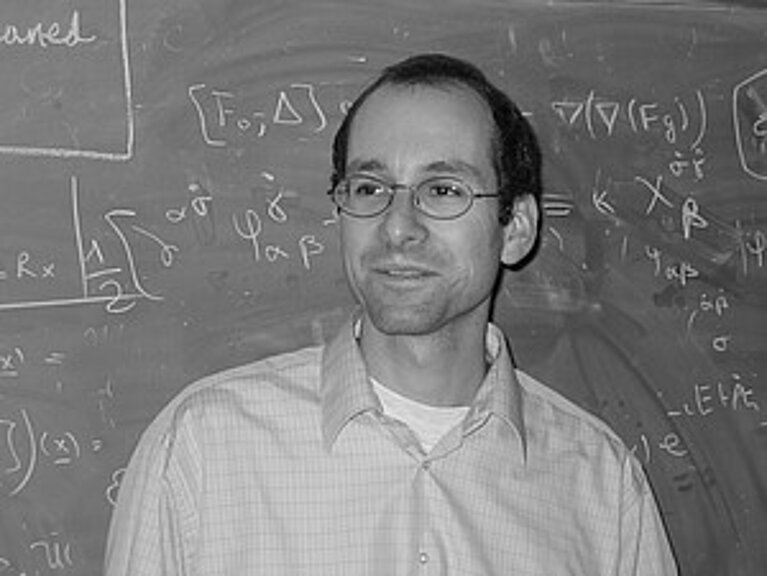March 24, 2014 - by Simone Ulmer
What was your first thought when you learned about the research findings of the BICEP-2 working group?
Martin Kunz: Actually there were two. On the one hand, I was excited that the primordial gravitational waves had been found. I admire the work of the BICEP2-Team. On the other, I asked myself whether the detection could have been triggered by something else as the measurements are relatively complicated. It is very easy to make mistakes. If, however, the results are correct, then this is one of the biggest discoveries in physics this decade, on a par with the Higgs particle. Perhaps the primordial gravitational waves are even more important, in terms of current research, than confirmation of the Higgs mechanism, as what we are experiencing here is the beginning of a new research area.
Was a breakthrough of this nature to be expected using an earth-based telescope?
Earth-based telescopes can always draw on the latest technologies and are kept very much up to date. This result was obtained with a second and third generation BICEP telescope (BICEP2 / Keck array). Technologically speaking these telescopes are far more advanced than the Planck satellite. However, on earth it is more difficult to measure large areas in the sky and to control errors. What is certainly surprising is the strength of the signal. Based on the Planck results most cosmologists would probably have expected a far weaker signal.
It is not possible to directly observe the gravitational waves only their impact as a specific pattern in cosmic background radiation, in what are known as B-modes. How do these patterns form and how can you detect them?
In quantum physics there must always be small fluctuations in all fields because of Heisenberg’s uncertainty principle. During inflation these quantum fluctuations were blown up to giant scales. The inflation field is normally, like Higgs, a scalar field. Its fluctuations become “scalar” density fluctuations that do not generate any B-modes in polarisation. Later they grow under the influence of gravity and form, for instance, galaxies, stars and planets. In addition, there are also small gravitational wave fluctuations that are also blown up during inflation. They differ from the density fluctuations and generate polarisation described as B-modes. BICEP2 has now measured this B-polarisation on large scales where gravitational waves are particularly important. Based on these theories primordial gravitational waves are seen as evidence that there is a quantum theory for gravity.
The underlying quantum theory probably still has to be formulated or not?
You can extend the general theory of relativity into a quantum theory and calculate predictions. You do then see that this theory no longer works at high energies like the Planck energy of 1019 gigaelectron volts, an energy 1015 times higher than that of LHC at CERN, or in the case of very highly curved spaces like in black holes. But when the inflation has taken place at a late enough stage, then the predictions of this effective quantum relativity theory should be very good. If the BICEP2 measurements are correct, then we have witnessed physical effects that do not exactly happen at the Planck energy but are rather lower by rouhgly 3-4 orders of magnitude. But they do still correspond to an energy that is many billions of times higher than we could ever achieve on earth.
If the cosmologists have indeed proved the existence of gravitational waves that in turn confirm inflation, could you then perhaps confirm the existence of cosmic strings?
If the signal detected by BICEP2 really comes from gravitational waves, then they are indeed very likely to come from inflation. But we have at least two sources of gravitational waves which BICEP2 may have seen: firstly the ones that are directly created during the inflationary phase and secondly the ones which are generated by the cosmic strings themselves if at the end of the inflation there really are topological defects.
You are coming closer to proving the existence of cosmic strings through the data of the Planck satellites and simulations on supercomputers. Do your results and the Planck data match the results of the BICEP2 working group or are there inconsistencies?
So far Planck has only evaluated the pure temperature data without polarisation. They didn’t find any signal for gravitational waves. The limit of the strength of gravitational waves is slightly lower than what the BICEP2 measurements seem to have found. The Planck group will definitely now compare its own data including polarisation with those of BICEP2. Planck observes the entire sky and measures several frequencies simultaneously but the Planck instruments are less sensitive than the much more recent BICEP2 detectors. This makes for an interesting comparison. Of course, our group also immediately compared the BICEP2 data with our predictions for cosmic strings and already published a short, initial article on this subject.
What did you find out?
We found out that cosmic strings alone are unable to reproduce the BICEP2 data as the size distribution of fluctuations in the B polarisation does not have the right form. Inflationary gravitational waves fit much better but not entirely either. What fits best right now is a mixture of the two but we still have to conduct a precise analysis. Our new predictions, which we calculate with the help of simulations at CSCS, are still not quite finished.
